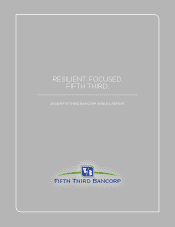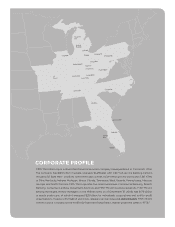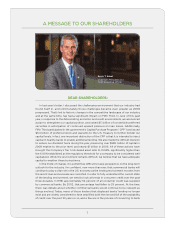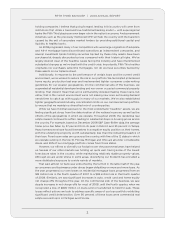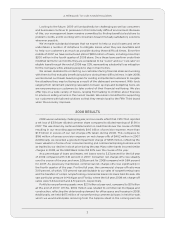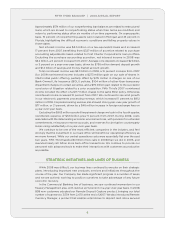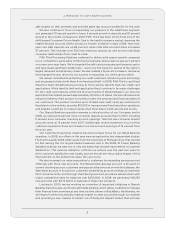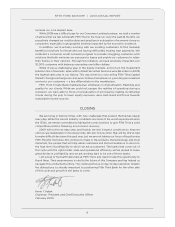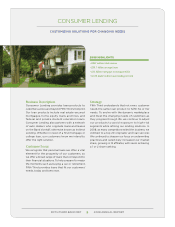Fifth Third Bank 2008 Annual Report Download - page 5
Download and view the complete annual report
Please find page 5 of the 2008 Fifth Third Bank annual report below. You can navigate through the pages in the report by either clicking on the pages listed below, or by using the keyword search tool below to find specific information within the annual report.
3
A MESSAGE TO OUR SHAREHOLDERS
Looking to the future, 2009 will undoubtedly be challenging as well as consumers
and businesses continue to persevere in this historically difcult environment. Because
of this, our management team remains committed to nding benecial solutions to
problem credits, and to working with consumers toward mutually satisfactory solutions
whenever possible.
We’ve made substantial changes that we expect to help us avoid losses and we’ve
undertaken a number of initiatives to mitigate losses when they are inevitable and
to help our customers as much as possible during these difcult times. Since the
middle of 2007, we have restructured almost $800 million of loans, including more than
$200 million in the fourth quarter of 2008 alone. Once these loans perform under their
modied terms for six months, they are considered to be “cured” and our “cure rate” on
eligible loans through the end of 2008 was 32%, representing substantial loss mitigation
for the Company while allowing people to stay in their homes.
We remain dedicated to contacting our customers facing nancial stress and working
with them to nd mutually benecial solutions during these difcult times. In late 2008,
we introduced our Dream Guard program for existing and potential customers to navigate
the situations they may be facing as a result of the distressed environment. With tools
ranging from retirement planning calculators to basic savings and budgeting tools, we
are empowering our customers to take control of their nancial well-being. We also
offer tips on a wide variety of topics, ranging from talking to children about nances
to advice on selling a home in the current market. We remain committed to supporting
our customers with tailored solutions so that they remain loyal to the Fifth Third brand
when the economy improves.
2008 results
2008 was an extremely challenging year, and our results reect that. Fifth Third reported
a net loss of $3.94 per diluted common share compared to diluted earnings of $1.99 in
2007. This was driven by continued deterioration in credit trends over the course of 2008,
resulting in our recording approximately $4.6 billion of provision expense, more than
$1.9 billion in excess of our net charge-offs taken during 2008. This compares to
$166 million of excess provision expense on net charge-offs of $462 million in 2007.
Additionally, we recorded a goodwill impairment charge of $965 million, reecting the
lower valuation of some of our consumer lending and commercial banking business units
as implied by our decline in stock price during the year. Many other banks incurred similar
charges in 2008, as the KBW Bank Index fell 50% over the course of the year.
As a percentage of loans and leases, net losses rose to 3.23 percent for the full year
of 2008 compared with 0.61 percent in 2007. Consumer net charge-offs rose steadily
over the course of the year, and were 2.08 percent for 2008 compared with 0.84 percent
for 2007. As previously mentioned, commercial net charge-offs rose signicantly in
the fourth quarter of the year. For the full year, the commercial charge-off ratio was
3.99 percent, of which, 1.59 percent was attributable to our sales of nonperforming loans
and the transfers of certain nonperforming commercial loans into loans held-for-sale. We
saw particular pressure in Michigan and Florida, where the full year 2008 net charge-off
ratios were 5.44 percent and 8.51 percent, respectively.
Portfolio nonperforming assets were $2.5 billion at year-end, compared to $1.1 billion
at the end of 2007. Of this, $902 million was related to commercial mortgage and
construction, reecting the deteriorating demand for ofce space and housing in 2008.
Additionally, we held $473 million of nonperforming commercial loans in held-for-sale,
which we would anticipate removing from the balance sheet in the coming periods.

